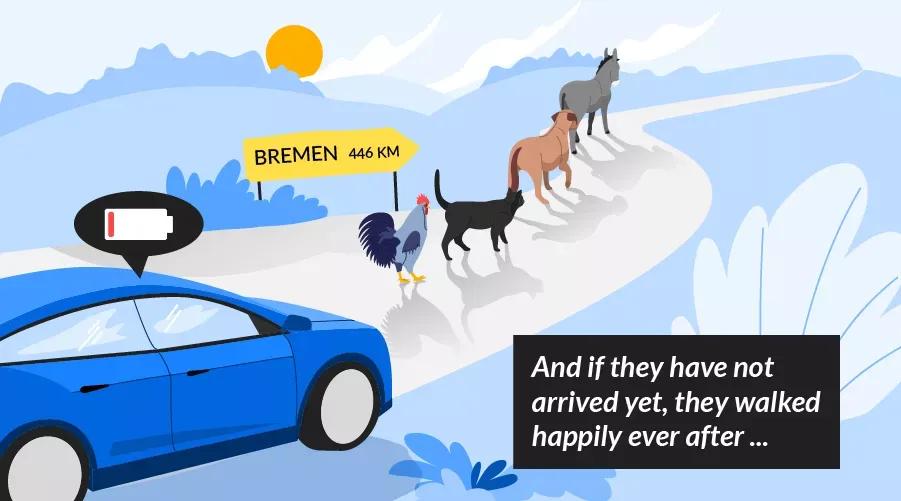As an experienced expert in the field of intelligent charging and energy solutions, The Mobility House has set itself the goal of taking a closer look at widespread fairy tales surrounding e-mobility and questioning them. The following article takes a closer look at the ranges of electric vehicles.
Once upon a time...there was an electric car with a short range
Friends in the other part of the country, parents in the hometown, holidays abroad: sometimes you must really unwind kilometers to reach your destination. Since several providers such as Ionity, Innogy, EnBW, Fastned or Tesla have set up countless attractive fast-charging locations with their supercharger network along the motorways and highways, long distances are no longer a problem with the electric car.
Today's e-car models leave range anxiety behind
The usual daily distances are easily covered by electric cars anyway: Even the small smart EQ manages more than 130 kilometers before it must be plugged in again. Other small electric cars such as the almost identical in construction VW Group trio VW e-Up!, Seat Mii electric and Skoda Citigo-e cover 260 kilometers. Compact class models such as the popular BMW i3, Nissan Leaf and Renault Zoe or the new Opel Corsa-e, Peugeot e-208 and VW ID.3 can travel a good 300 to 400 kilometers on one battery charge. For limousines and SUVs from the middle class upwards, 400 to 500 kilometers are the norm.
Since September 2017, such ranges have been reported using the WLTP (Worldwide Harmonized Light-Duty Vehicles Test Procedure) measurement method and the New European Driving Cycle (NEDC) introduced in 1992 has been replaced. The aim of this change was to achieve a more realistic measurement. There is no general answer to the extent to which this has been achieved. This is because, as with gasoline cars, factors such as weather conditions, outside temperature or topography play a role and influence the range alongside individual driving behavior. Particularly in colder seasons, electric car drivers should therefore anticipate losses in terms of battery endurance. These losses amount to approximately between 10 and 30 percent.
Commuters travel less than 50 km a day on average
Irrespective of this, however, it can be concluded that electric cars have a range that is absolutely suitable for everyday use when compared with the driving profile of an average German car: on average, a classic commuter car covers 30 kilometers in two trips every day. Almost two thirds (64 percent) of the car journeys in everyday traffic are even shorter than ten kilometers, 95 percent are shorter than 50 kilometers. Even for the smart EQ this does not pose a problem, even if a generous fifth of the range loss is considered for the cold winter months. Small cars such as the VW trio would only need to be plugged in once a week for an average commuter.
Different charging times (DC)
However, if you want to drive a long-distance electric car with a high comfort factor, you should pay attention to a few things during the purchase: Because not every electric car can charge up at the same rate. Some models, especially older ones, can achieve a maximum of 50 kW. The latest generation of electric models that are currently coming onto the market, as well as the Tesla models that have always been trimmed for long-distance capability, are better equipped for short charging times with charging capacities of well over 100 kW - and sometimes considerably more. Within just 30 minutes, these electric cars recharge energy for more than 250 kilometers on a highway. High Power Chargers, also known as Ultrasonic Fast Chargers, even have a charging capacity of up to 350 kW. At such a charging station, electric cars that can use the full power can even recharge the battery in only three to four minutes for a range of up to 100 km.
The size of the battery and driving style also play a role on long journeys. Rule of thumb: vehicles with a battery size of 40 kWh or more are generally considered suitable for long journeys. This capacity is easily enough for a good 200 kilometers of highway - as long as you are in no hurry and do not rush along the left lane with full speed.
Here is another thought: Drivers and passengers also have a limited range. When the energy to sit and be still runs out or nature calls, a break is due. The (German) ADAC recommends interrupting longer journeys for at least 20 minutes every 200 kilometers or every two hours at the latest. That is enough time to stretch your legs, get a small snack and drink - and a generous amount of time to recharge the electric vehicle.
